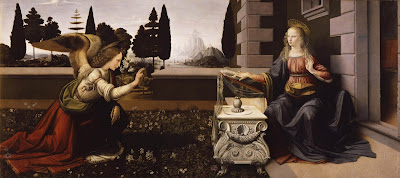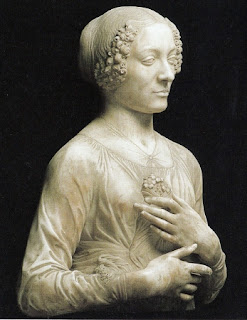Edward Hutton regarded Andrea Verrocchio as "one of the greatest of all Italian masters of the Renaissance." Sadly, Verrocchio has been eclipsed by his student Leonardo da Vinci. For example, the famous Annunciation in the Uffizi is generally credited to the young Leonardo although it was done in the Verrocchio studio.* In the Bargello, Hutton found two outstanding examples of Verrocchio's work as a sculptor.
It is, however, in the work of another goldsmith—or at least the pupil of one, whose name he took—that we find the greatest master of the new age, Andrea Verrocchio. Born in 1435, and dead in 1488, he was preoccupied all his life with the fierce splendour of his art, the sublime sweetness that he drew from the strength of his work. The master, certainly, of Lorenzo di Credi and Leonardo, and finally of Perugino also, he was a painter as well as a sculptor; and though his greatest work was achieved in marble and bronze, one cannot lightly pass by the Annunciation of the Uffizi, or the Baptism of the Accademia. Neglected for so long, he is at last recognized as one of the greatest of all Italian masters of the Renaissance. …
More perfect in craftsmanship and in the knowledge of anatomy than Donatello, Verrocchio here, where he seems almost to have been inspired by the David of his master, surpassed him in energy and beauty, and while Donatello’s figure is involved with the head of Goliath, so that the feet are lost in the massive and almost shapeless bronze, Verrocchio’s David stands clear of the grim and monstrous thing at his feet. Simpler, too, and less uncertain is the whole pose of the figure, who is in no doubt of himself, and in his heart he has already “slain his thousands.”
In the portrait of Monna Vanna degli Albizi, the Lady with the Nosegay, Verrocchio is the author of the most beautiful bust of the Renaissance. She fills the room with sunshine, and all day long she seems to whisper some beloved name. A smile seems ever about to pass over her face under her clustering hair, and she has folded her beautiful hands on her bosom, as though she were afraid of her beauty and would live ever in their shadow.
In two reliefs of Madonna and child, one in marble and one in terra-cotta, you find that strange smile again, not, as with Leonardo, some radiance of the soul visible for a moment on the lips, but the smile of a mother happy with her little son. In the two Tornabuoni reliefs that we find here too in the Bargello, it is not Verrocchio’s hand that we see; but in the group of Christ and St. Thomas at Or San Michele, and in the fierce and splendid equestrian statue of Bartolomeo Colleoni at Venice, you see him at his best, occupied with a subtle beauty long sought out, and with an expression of the fierce ardour and passion that consumed him all his life. If he makes only a leaf of bronze for a tomb, it seems to quiver under his hands with an inextinguishable vitality.
###
*Today the Uffizi credits the Annunciation to Leonardo but after a Verrocchio prototype.
Edward Hutton: Florence and Northern Tuscany with Genoa, second edition, London, 1908. Pp. 292-293.




thank you for the beautiful art
ReplyDeleteDO comments from the UK: A very good piece. I've never gone along with the myth of Verrocchio giving up because of the talent of Leonardo. What is astonishing is how multitalented artists were at the time - who could both sculpt and paint to that standard these days?
ReplyDeleteThe piece also points out the importance of workshops - we are obsessed with artists as creative individuals, especially when works come up for auction - is it a genuine Leonardo? the cry goes out.